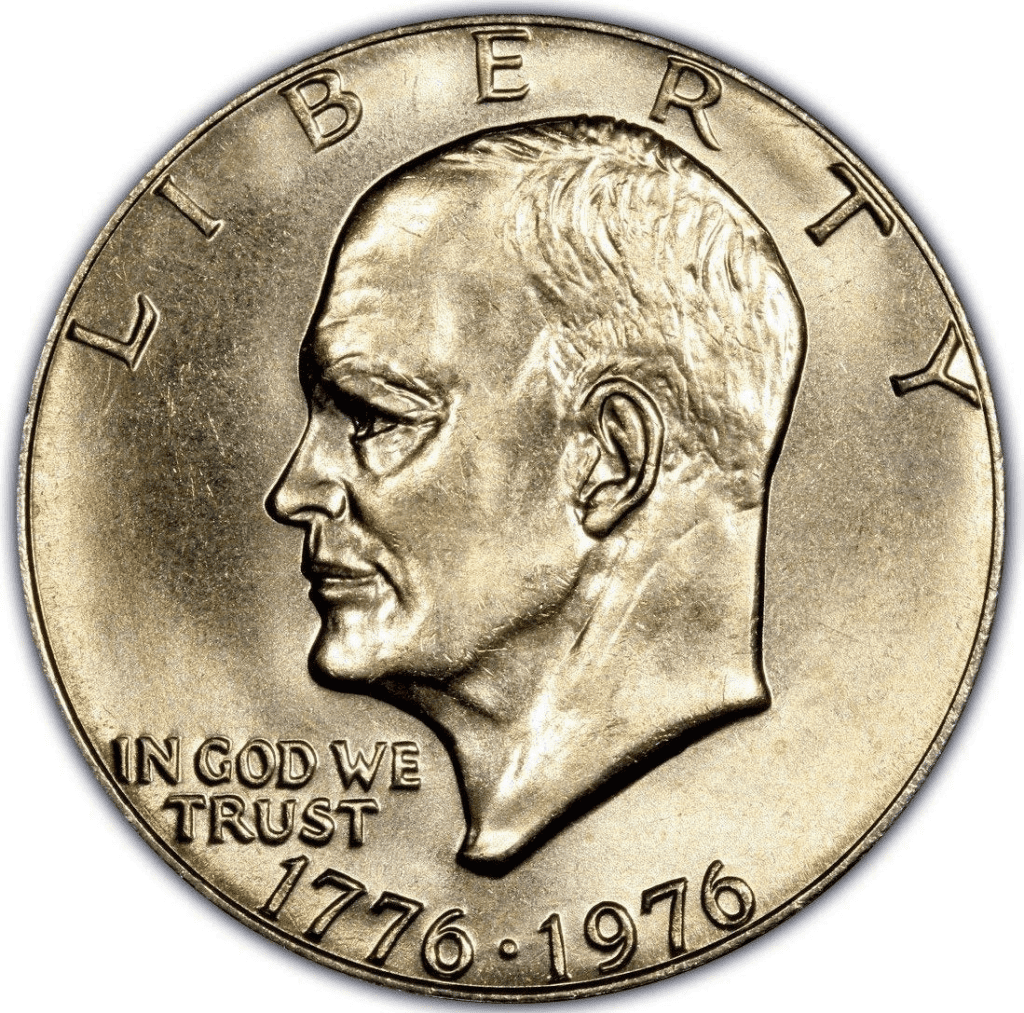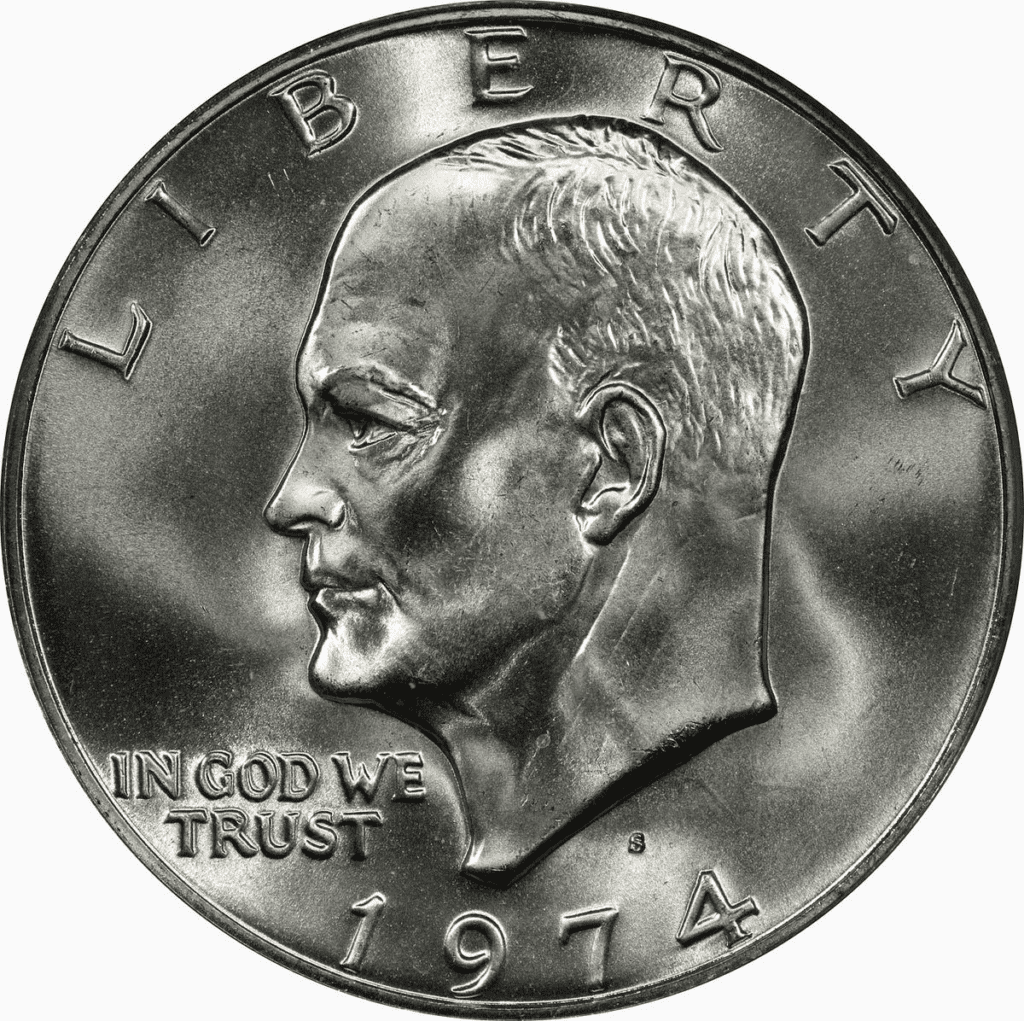What Is The 1976 Eisenhower Dollar Made Of?
The 1976 Eisenhower dollar or the 1776-1976 bicentennial Eisenhower dollar was made of 75% copper and 25% nickel. There is also a silver coin variety that is made of 40% silver.
Since the 1976 series coincides with the 200th birth of the United States of America, a unique commemorative design was used. Thus, you will not find a 1976 Eisenhower dollar. Instead, you’ll find a dollar coin with two dates, 1776-1976. The dollar coins struck in 1975 and 1976 bear these two dates.
The 1776-1976 Eisenhower dollar has the image of Dwight Eisenhower, the 34th US president, facing to the left side. On the obverse side, you’ll find the following inscriptions:

photo source: Numista
- LIBERTY
- IN GOD WE TRUST
- 1776-1976
- Mint mark (if present)
The usual Eisenhower dollar coin has the eagle on its reverse side. However, you’ll find the Liberty bell in front of the Moon for the commemorative coin version. The Liberty bell symbolizes freedom while the Moon, the Apollo 11 insignia, reminds people about the 1969 moon landing.
The inscriptions included on the reverse side are the following:

photo source: Coin Values
- UNITED STATES OF AMERICA
- E PLURIBUS UNUM
- ONE DOLLAR
- Designer’s initial (DRW, Dennis R. Williams)
The United States Bicentennial coinage included not just the dollar, but also the half dollar and quarter. The bicentennial coins faced opposition when it was first conceptualized.
In the past, commemorative coins were abused. As a result, the U.S. Mint advocated to never again create commemorative coins starting in the 1950s.
However, this all changed in 1971 when some members of Congress wanted to create commemorative coins for the 200th anniversary of the founding of the United States. Mary Brooks, the Mint director at that time, eventually supported the move. Only the reverse side of the dollar, half-dollar, and quarter coins were changed.
The reverse design of the dollar was determined through a competition open to the public. Dennis R. Williams, a 22-year-old art student at that time, won the competition. Once the design was approved, the 1776-1976 dollar coin was set for the mintage process.
1976 Eisenhower Dollar Rarities And Varieties
The 1976 Eisenhower dollar went through different design changes in just a short time. Thus, there are different varieties and even rarities known.
Here are some of the varieties you should know:
1976 Dollar (No Mint Mark)
Metal Composition: 91.67% copper, 8.33% nickel
Diameter: 38.1mm
Weight: 22.68 grams
Edge: smooth

photo source: Amazon
The mint mark is missing, but coins with no mint mark are understood to have been struck in Philadelphia.
1976-D Dollar
Metal Composition: 91.67% copper, 8.33% nickel
Diameter: 38.1mm
Weight: 22.68 grams
Edge: reeded

photo source: NGC
The “D” mint mark indicates that the coin was struck in Denver.
1976-S Dollar
Metal Composition: 91.67% copper, 8.33% nickel
Diameter: 38.1mm
Weight: 22.68 grams
Edge: reeded

photo source: Wikipedia
The “S” mint mark indicates that the coin is struck in San Francisco.
You might wonder if there’s a 40% Silver 1976 dollar coin. Yes, there is. However, they were not made for circulation but rather created to be given or sold to selected individuals.
It is worth noting that all the standard varieties of the 1976 dollar coins have two reverse versions. These are the following:

photo source: www.usacoinbook.com
- Type 1 – Low Relief – Bold Lettering
- Type 2 – Sharp design – Delicate Lettering
In 1975, the type 1 version of the reverse side of the coin was struck. However, during its production, the US Mint noticed that there was a problem in the process. The die was designed to strike silver and since copper-nickel is used, the die was striking improperly.
As a result, the Mint called for the production to stop until a new die is created. That was when the Type II reverse side of the dollar coin was made.
The main difference is the letters of “UNITED STATES OF AMERICA” were changed into thicker and bolder letterings.
1976 Dollar: 40% Silver – Type 2 – No “S”

photo source: USA Coin Book
The unique 1976 no mint mark (No “S”) type 2 with a silver surface is probably the rarest variety of the Eisenhower dollar coin. In fact, there’s only one of its kind known to exist. The image above is what the rare 1-dollar coin looks like.
So, how did the unique silver 1976 dollar coin come about? No one can actually tell for sure. There are a few theories circulating around, but the facts haven’t fully been established.
The US Mint believed that the one-of-a-kind silver one-dollar coin was created in Philadelphia. It is intended to serve as a trial version that would be presented to the management. For some reason, the coin ends up in circulation.
Perhaps, it was presented to one of the members of Congress. Mistakenly thinking that the coin was just an ordinary coin, that person then used it to pay for services or products.
The special coin was then later discovered in a department store in Washington DC, a store named Woodward and Lathrop.
Today, Mitchell Spivack owns the special 1-dollar coin. He is a modern coin expert who sees the silver 1976 Eisenhower coin as the rarest coin in US history. What makes this coin extra special is it is even a coin used to commemorate the 200th anniversary of US Independence.
1976 dollar coin list of errors
For the 1976 dollar coin, there are a few errors that happened during the production. Some of these errors are known as the following:
- Blank planchets
- Off-center strikes
- Multiple strikes
- Doubled died
- Clipped planchets
- Broad strikes
How Much Is A 1976 Eisenhower Dollar Worth Today?
The value of the 1976 Eisenhower dollar depends on various factors. However, if you are selling an ordinary and circulated dollar coin, it would simply be sold for slightly higher than $1. The melt value of the 1976 dollar coin is also $1.
The more expensive varieties would be the 1 dollar coins with errors. Just to give you an idea, a 1976 Eisenhower dollar with off-center strikes can be sold for $550. The coin that received multiple strikes can even be sold for $1,000. Some of the most expensive 1776-1976 silver dollars are worth as much as $30,000.
How Does The Grading System Work?
The Sheldon Scale is used by numismatists to provide a numerical value to coins. The Sheldon Scale goes from poor (P-1) to perfect mint state (P-1) (MS-70). Coins were originally evaluated using words to reflect their condition (Good, Fair, Excellent, Etc.). Unfortunately, coin collectors and dealers had different ideas about what each of these terms represent.
Professional numismatists joined together in the 1970s and established CoinGrading standards. These numismatists now assign grades at key places on the seventy-point scale, using the most regularly utilized numeric points in conjunction with the original adjective grade. The following are the most common coin grades:
-
-
- (P-1) Poor – Indistinguishable and probably damaged; if used, must have a date and mintmark; otherwise, rather battered.
- (FR-2) Fair – Nearly smooth, but without the damage that a coin graded Poor often possesses. The coin must have enough detail to be identified.
- (G-4) Fair – Inscriptions have merged into the rims in some areas, and important elements have been mostly erased.
- (VG-8) Very Good- A little weathered, but all of the primary design elements are visible, albeit faintly. There is little if any, central detail left.
- (F-12) Good – The item is very worn, yet the wear is even, and the overall design details stand out clearly. Rims are almost completely isolated from the field.
- (VF-20) Very Fine – Moderately weathered, with some finer features still visible. The motto or all letters of LIBERTY are readable. Both sides of the coin have entire rims that are separated from the field.
- (EF-40) Extremely Fine – Gently used; all gadgets are visible, and the most important ones are bold. The finer details are bold and clear, however, light wear may be seen.
- (AU-50) Uncirculated – Slight evidence of wear on the coin’s design’s high points; may have contact marks; eye appeal should be adequate.
- (AU-58) Uncirculated Choice – Slight traces of wear, no severe contact marks, almost full mint shine, and great eye appeal.
- (MS-60) Mint State Basal – Strictly uncirculated; no indication of wear on the coin’s highest points, but an unsightly coin with reduced luster, visible contact marks, hairlines, and other flaws.
- (MS-63) Mint State Acceptable – Uncirculated, but with contact scratches and nicks, little reduced shine, but otherwise appealing appearance. The strike is weak to average.
- (MS-65) Mint State Choice – Uncirculated with great mint shine, very little contact blemishes, and exceptional eye appeal. The strike is unusually severe.
- (MS-68) Mint State Premium Quality – Uncirculated with superb luster, no obvious contact marks to the naked eye, and exceptional eye appeal. The strike is quick and appealing.
- (MS-69) Almost Perfect Mint State – Uncirculated with perfect brilliance, a sharp and appealing strike, and extremely good eye appeal. A near-perfect coin with minor imperfections in the planchet, strike, and contact markings (seen only under 8x magnification).
- (MS-70) Mint State Perfect – Under 8x magnification, there are no tiny imperfections discernible; the strike is crisp, and the coin is perfectly centered on a beautiful planchet. Rarely seen on a coin, this coin is bright and whole, with original luster and exceptional eye appeal.
-
Where To Buy 1976 Eisenhower Dollar?
There were over 220 million 1776-1976 bicentennial 1-dollar coins struck and these were released into circulation in October 1975. More Eisenhower dollar coins were struck in the following years until it was discontinued in 1978.
So, there are a lot of 1976 dollar coins and you can easily find them. If you’re planning to buy one, the quickest way to find them would be the Internet. eBay and Amazon are among the most known places to buy your next coin. Facebook also has a special place called Facebook Marketplace where you can also look for the 1976 Eisenhower dollar.
Aside from the Internet, you can also visit coin shops, antique shops, and coin collectors’ hubs. You can also ask around. If possible, join clubs of coin collectors and you should be able to widen your network and find the right coin for you.
If you have a 1976 Eisenhower dollar coin or you are looking for a good coin to buy, look for the Eisenhower silver dollars. However, how can you know if your coin contains silver?
First, you need to check the date. The Eisenhower silver dollars were made from 1971-1976.
Next, check the mint mark. Look for the coins made in San Francisco. It should have a mint mark of “S.”
If there’s no mint mark, it is more likely to be made in Philadelphia. If you see the “D” mint mark, that coin was made in Denver. Coins made in Philadelphia and Denver are less likely to be made of silver.
Finally, look at the edge of the coin. If you see that you have solid silver stripes, then that coin is more likely to be made of 40% silver.
FAQ
How to know if a 1976 Eisenhower dollar is silver?
A 1976 Eisenhower dollar is more likely made of silver when you see it has solid silver stripes on its edge. A silver 1976 Eisenhower dollar also has an “S” mint mark. To confirm, get your coin tested and assessed by qualified coin grading service providers.
How much silver is in a 1976 Bicentennial Eisenhower dollar?
The silver 1976 Bicentennial Eisenhower dollar has 40% silver content and the rest is copper or nickel.
What makes a 1776-1976 Eisenhower dollar rare?
The 1776-1976 Eisenhower dollar is rare if it is made of silver, uncirculated, and proof.







